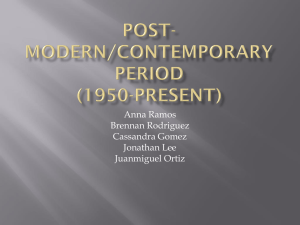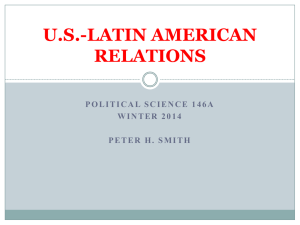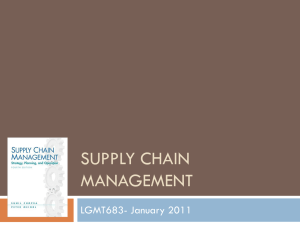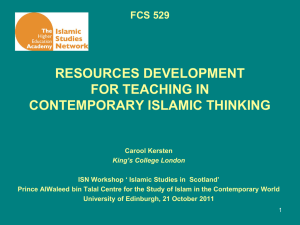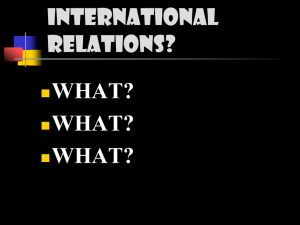Strategy - Classic and Contemporary views
advertisement
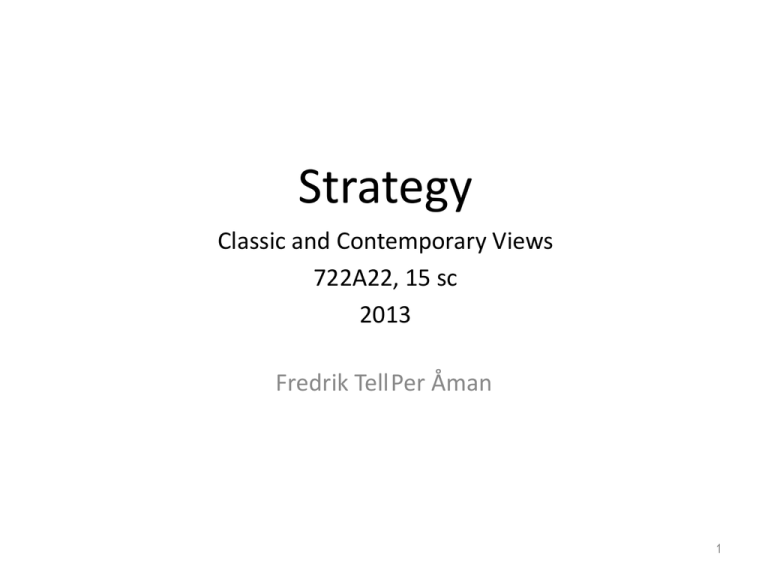
Strategy Classic and Contemporary Views 722A22, 15 sc 2013 Fredrik TellPer Åman 1 Strategy “Strategy is about achieving success…. - Goals that are consistent and long term - Profound understanding of the competitive environment - Objective appraisal of resources - Effective implementation” Grant, 2013, p5 2 The contemporary Globalization Scale, scope, reach, diversity, distance; costs, competition Dynamics Pace, change, time, process, Innovation; product and process, uncertainty Knowledge, IPR, expressiveness, meaning, values Intangibles Ethics and sustainability issues Reputation, social responsibility, green 3 Evolution of a canon Market perspective Resource perspective Fast Best Big 1960 1970 1980 Beautiful 1990 2000 2010 4 The contemporary and the canon The Big Wave – competing on volume The Best Wave - competing on positions and resources The Fast wave – competing on speed The Beauty wave – competing on aesthetic and symbolic value 5 The SCCV course • The canon, the classics and the contemporary • Group diversity – Sprek, Ekonomprogrammet, One-year master, HRM&D Master, and SMIO, Erasmus – Mixed workgroups • English as course language – Exams, reports, lectures, seminars etc. • Master’s level • Previous knowledge differs. • Different interests and expectations • Literature and reflection • Market and resource/ organizational views. – Inside and outside the organization(s). 6 SCCV Course structure and content - 2012 Big, Forest Fast Business industry Best (continued) game case & Fast Test Intro Value - concept - creation - capture Product/market Flows matrix Innovation SWOT Exploration/ Growth/share matrix exploitation Generic strategies Strategic groups Value chain/system Resource Based View Ind.exam Beauty - structure slightly Compressed the first weeks Outro changed Forest industry - B, B & F Prius case - paper assignment Business game case week - Test! slightly revised. - moved extended Dynamic capabilities Knowlegde creation Supply chains Replication Beautiful Outro Aesthetics Brands Management of meaning Identity CSR • Other changes – Literature. Article list revised. – Examination structure slightly changed. – Fewer assignments 7 SCCV Examination (preliminary) • Written individual exam (40 %) – ”Big, Best, and Fast” • Paper (40 %) to be written in pairs • Relating ”Beauty” to previous view(s) of competitive advantage. • Seminar assignment in groups (20 %) • Groups to be formed by the course management • ”Test” (5 additional %) – Not compulsory. Can not be retaken. – You mast pass the ind.exam, Prius and paper in order to include it in your total score. – A ”bonus”. • Other assignments – passed. • Will be clearly indicated on the assignments. • These will primarily be done in groups. 8 Welcome! 9 Course structure and content - changes 2009 Individual paper introduction • Fast - compressed Big & Best Fast Product/market matrix SWOT Growth/share matrix Generic strategies Strategic groups Value chain/system Blue oceans Business Fast(continued) game Flows Innovation Exploration/ exploitation Value creation Value constellations Value capture Beautiful - expanded Business game - minor changes Beautiful Supply chains Replication Resource Based View Knowlegde creation Dynamic capabilities Outro - more time for individual paper. Ind.exam Intro Intro - revised in order to provide a better view of the course. Outro Aesthetics Brands Management of meaning Identity CSR Other changes – Fewer group assignments. – Literature. One book + articles. – Examination structure changed – more emphasis on individual performances (80/20) 10 BBFB • • • A narrative: the evolution of strategic management Alternative sources of competitive advantage Bases for integrated strategic management 11 The course in its context • A strategy profile – a combination of – – Our course, and Your choices • • within the course of next course + master thesis (20p) subject Strategy - CCV Course Master Thesis 12 Strategy - Classic and Contemporary Views • Classic – the canon of strategy –”Required” knowledge of concepts, models etc. • Does not give any competitive advantage, more or less a standardised global commodity. • Contemporary –Reflect contemporary practice. • Resources, capabilities, processes and flows, projects, networks • Aesthethics and identity as means of competitive advantage –Reflexive regarding classic as well as contemporary. • A possibility to achieve something beyond ’recieved/required’ knowledge. • … and … –It is not classic vs. contemporary views. It is classic and contemporary views. 13 • 15 hp advanced course in English • For students from: • Sprek, Ekonomprogrammet, One-year-master, Master in HRM&D (722A04), and Strategy and Management in International Organizations (SMIO), Exchange master students (722A22) 14 Aims and Objectives • The aim of the course (,i.e. it’s learning outcomes) is to enhance students’ capabilities to act and work in contemporary and future organizations. A course ambition is to educate discerning consumers of strategic thought, i.e. students able to reflect upon fads and fashions and achievements of management research and writings. • After the course the students will be expected to be able to: – Reproduce central strategic concepts and ideas as well as the development of the field of strategic management. – Illustrate and explain differences and similarities between major ways of strategic thinking. – Be able to compare and relate thoughts and elements from different schools of strategic thinking. – Make use of models and concepts. – Differentiate between and select appropriate theories and models for different situations. • In addition to this, the students will have gained experience of working in culturally/ethnically/nationally diverse teams. 15 Course content • The course is based on four complementary views of how competitive advantage is created. These are based on different ‘waves’ of strategic thinking since the late 60:ies. Big - refers so size-related ´competitive advantages (ex. the BCG matrix). Best - refers to positioning (ex. Porter’s 5 forces, strategic groups). Fast - refers to speed of internal processes as well as speed regarding product/market development and innovation. Resource Based Views are also handled here. Beautiful - refers to aesthetic dimensions of value and competitive advantage Fast Best 4 complementary views of Competitive Advantage Big 1970 1980 Beautiful 1990 2000 2010 16 Classic and • A-F-I • S-C-P • A Number of ”must-knows” (and understand) – Models (BCG, 5 forces etc.) – Concepts (synergy, conglomerate etc.) Contemporary • The classic views in their contemporary context • Aspects as – – – – Innovation and change Resource-based view Dynamic capabilities ’Beauty’ • Significance and substance • Obs! Classic does not mean outdated. – The ’early’ models and concepts of strategy are still much in use. • Big, Best, Fast, and Beautiful – Our way of structuring the course. – Not to be conflated with theories, models etc. 17 2009/2010/2011 courses • • Changes 2009 – More ’beauty’, a little less ’fast’. – Examination structure changed (ind 80%, group 20%). – Literature list revised. • Changes 2011 – Minor structural changes – New assignments – Course outline in a new fashion Changes 2010 – Minor structural changes. – New book (Grant). • Literature list accordingly revised. – Paper written in pairs. – Examination • Individual exam on Big, Best, and Fast sections after 6½ weeks. • Paper assignment to examine the beauty part. 18 The 2009/2010/2011 courses according to course evalutations • Content and structure – Good! – – ”Content was structured in a way that alllows a good analysis of today’s strategy scenario.” (722A22) ”The clear structure and the ”red line” through the whole course.” (722A04) • Workload – Much, but not too much. – A bit negative regarding parts of the literature. • Much less ”small group” problems compared to earlier years. – Still some difficulties with different levels of ambition. – Cf. Grants’ discussion on coordination and cooperation • Too many ’small’ assignemnts 19 Course structure and content - changes 2010 Intro Value - concept - creation - capture Big & Best Fast Business game Product/market Flows matrix Innovation SWOT Exploration/ Growth/share matrix exploitation Generic strategies Value creation Strategic groups Value constellations Value chain/system Value capture Resource Based View Business game Individual exam - minor changes moved Outro - paper assignment - On big, best, fast. revised. Fast (continued) Ind.exam Fast - second part restructured - RBV moved to Best - A ’retrospective overview’ to sum up and introduce Intro - revised. Dynamic capabilities Knowlegde creation Supply chains Replication Beautiful Outro Aesthetics Brands Management of meaning Identity CSR • Other changes – Literature. New book, article list revised. – Examination structure slightly changed. 20 When, where ”big” groups Brief description Readings 21 The course consists of ’loosely coupled’ • Lectures – L1-L13: To introduce topics and draw the thick lines. – Guest lectures: To add other perspectives and views. • Guest lectures are compulsory. • Seminars – For discussion and questioning • Your presence is expected. • Assignments and projects – To practice and develop skills .. – .. and for reflecting individually and in group • You are expected to contribute and do your very best! Obs! These are not decoupled! 22 Literature • Book: – Grant, Robert M. (2010) Contemporary Strategy Analysis (7th. ed.), Chichester: John Wiley & Sons Ltd. Mainly for Big, Best and Fast. • Articles and ’papers’ – According to the course’s literature list. – Articles will be available from various library databases. 23 Guests confirmed • Professor Robert M. Grant, Bocconi – ”Resources, capabilities and knowledge integration: applications to European football." • Håkan Dahllöf – Former CEO of ”Toyota Material Handling Europe” (previously known as BT, Mjölby) – Title: TBA 24 Examination ct. • All attempts to cheat will be reported to the disciplinary board. – You are required to have knowledge about the rules! • Link to ’Student examination guide’ on the course’s home page. – Strict academic requirements for reference handling, quoting etc are applied. – You are jointly responsible for your groups’ works. • Regarding groups, – If youy run into problems, solve them! 25 Overview • ”Time management” is up to you. 26 Welcome! • Questions? – Hans Andersson, 013- 282994, hans.andersson@liu.se – Fredrik Tell, 013- 282599, fredrik.tell@liu.se 27 28 Major changes last year (2009) • Fewer group assignments, more individual focus – Hopefuly without losing the benefits of groups. • Individual paper introduced week 1 – Tool for learning and reflection – May give a head start for thesis work (thesis proposal) – A response to student comments • More ’beauty’, a little less ’fast’. • Examination structure changed (ind 80%, group 20%). • Literature list revised (mostly regarding the ’contemporary’). • Skipped the Barney book. 29 The 2011 course • Some minor changes – Some new seminar assignments – A few new articles – Course outline document and literature list • Dates/times/’wheres’ only in TimeEdit. • Not changed – The basic idea and structure of the course. – Course management forms the small groups • Maximum diversity • Mixed groups required by programme directors – Examination structure • 80/20 • Paper in pairs 30 Tomorrow 33 BL32 34 Course survey 35 Strategy – Classic and Contemporary Views • Classic – the canon of strategy – ”Required” knowledge of concepts, models etc. • Contemporary – more complexity – Paradoxes – Processual – International 36 What is new, what is different? • Based on experiences from former courses, • International Business Strategy (10 points) • Corporate strategy – structure and change (20 points) • SCCV 2004, 2005, 2006 and some new ideas and changes, we have designed a course • that emhasises classic and contemporary views of competitive advantage 37 Changes 2007 • New integrative group assignment on IKEA. • More on the Resource Based View of strategy • No business game (due to resource cutbacks) • Worked well 2006 – – – – Introductory strategy process section Two individual exams No ‘big’ final case Individual paper at the end 38 Aims and Objectives • The aim of the course is to enhance students’ capabilities to act and work in contemporary and future organizations. A course ambition is to educate discerning consumers of strategic thought, i.e. students able to reflect upon fads and fashions and achievements of management research and writings. • The students will be expected to: – Reproduce central strategic concepts and thoughts as well as the development of the field of strategic management. – Illustrate and explain differences and similarities between major ways of strategic thinking. – Make use of models and concepts. – Differentiate between and select appropriate theories and models for different situations. – Be able to compare, relate and synthesize thoughts and elements from different schools of strategic thinking. – Evaluate and make judgements about strategies and ideas on strategy . 39 Best Fast Outro Big & Beautiful Intro Course structure 40 Course content • Main focus on one of three separate but related dimensions of strategy - Content – Process – an intense course start – Context unavoidable – where it happens • Loosely coupled series of – Lectures – Seminars – Assignments and projects 41 Loosely coupled… • Lectures – To introduce topics and draw the thick lines • Seminars – For discussion and questioning • Assignments and projects – To practice and develop skills .. – .. and for reflecting individually or in group – not decoupled! 42 According to de Wit & Meyer .. • “.. a learning situation must encourage students to be critical, must challenge them to be analytical, must force them to be mentally flexible and must demand creativity and unconventional thinking.” • “Students cannot be instructed to be strategists, but must learn the art of strategy by thinking and acting themselves – they must discuss, deliberate and do.” 43 Literature • Course text book: – de Wit, B. & Meyer, R. (2005) Strategy Syntehsis: Resolving Strategy Paradoxess to Create Competitive Advantage – Text and Readings (2:nd. ed)., London: Thomson Learning [ISBN 1-86152-965-1] • + Articles – required – recommended – individual choice (for projects and assignments) 44 Prospects • For students who want to act and work in, as well as understand, contemporary companies in their competitive contexts. 45 Prospects • For students who want to act and work in, as well as understand, contemporary companies, their contexts and processes. • Former student employers: – – – – – – Accenture Ericsson Telecom NZ Unilever 7-Eleven SAS 46 The 2008 course according to course evalutations • Content and structure – Good! – No major changes. • Individual paper assignment introduced at the start. • Workload – Much, but not too much. – About the same • Some group problems – Hard to predict. We tried to handle it. – Less focus on group assignments 2009. 47 48
